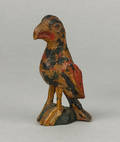$2,585
Early Mahogany and Brass Surveyor's Vernier Compass by Benjamin Hanks, with 6-inch dia. engraved paper card, large fleur-de-lis at North, thirty-two small fleur-de-lis at the outer points, the sub-cardinal points colored yellow, and scrolls at East, blued-steel needle on brass lifting arm, pasted label CW , inside scale divided 0-90° in four quadrants, with North and South marked 0 / 0 , and pewter needle ring with punched divisions in four quadrants extending to inner rim, the mahogany body with beaded brass bezel, socket and wheel clamp, brass vernier with bone scale operated from underside, vial and two screw-on brass sights with shaped tips, ht. 8 3/4 x lg. 15 3/8 in., in fitted wood case. Literature: Smart, The Makers of Surveying Instruments in America Since 1700 , p. 69 for illustration of a similar Hanks instrument. Benjamin Hanks was born in Mansfield in October 1755. His father, Uriah, was a farmer and watchmaker. In 1772, he left the family farm and became apprenticed to clockmaker Thomas Harlan in Norwich. Hanks fought in the Revolutionary War as a Tory, and then as a Whig, and from 1777 engaged in clock and watch making in Windham, moving to Litchfield in 1780 where he established a foundry for casting church bells. In 1783, he was granted a patent for his invention of a clock wound automatically by air, and in 1785 advertised his clocks, watches and surveyors' compasses.

Auctioneer:
Skinner
Date:
2006-07-29




















